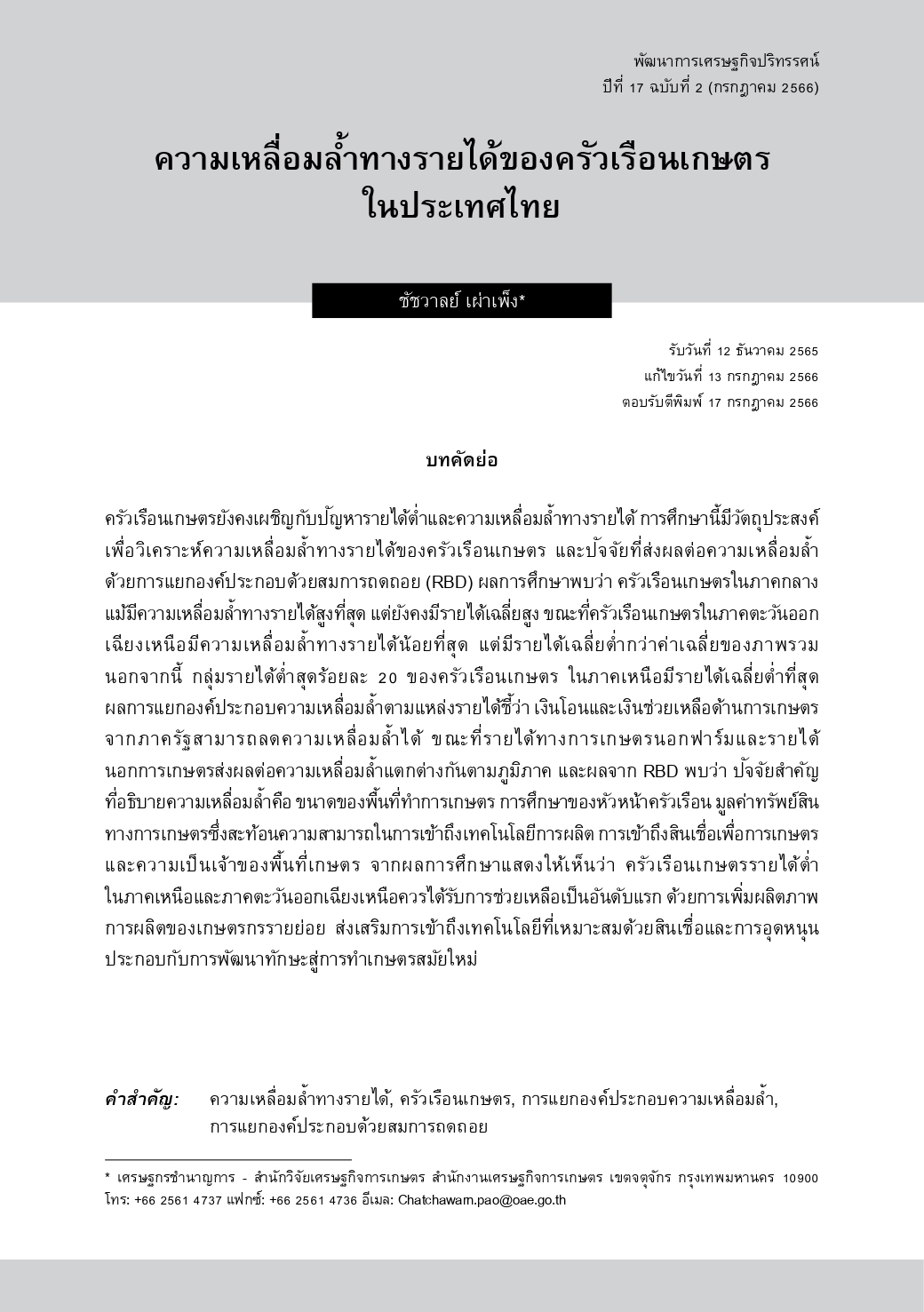Income inequality among agricultural households in Thailand
Keywords:
Income inequality, Agricultural households, Inequality decomposition, Regression-based decompositionAbstract
Poverty and income inequality are still essential problems faced by Thai agricultural households. This study aims to investigate income inequality among agricultural households in Thailand, as well as factors affecting this inequality by using regression-based decomposition (RBD) approach. The results demonstrate that, among agricultural households, the central region has the highest income inequality; however, the region’s average income is also high. On the contrary, the northeast region has the lowest income inequality, but its average income is less than the nation’s. Further, the average income of the poorest 20% of the households is the lowest in the north. When decomposing the inequality by income source, increasing transfers and agricultural subsidies would reduce income inequality, while off-farm and non-farm income differently affect the inequality regarding the regions. Lastly, the results of RBD indicate that the crucial factors explaining the inequality consist of operated land sizes, household head’s education, access to agricultural equipment and machinery, access to agricultural credit, and land ownership. These findings have significant implications for inequality. Poor agricultural households in the northern and northeast regions should be considered as the priority for assistance by improving productivity of smallholder farmers, promoting access to appropriate technologies through providing credit and subsidies as well as capacity building towards modern farming.
References
วิษณุ อรรถวานิช. (2564). รายงานการวิจัย การประเมินผลกระทบของนโยบายสาธารณะที่หลากหลายต่อความเป็นอยู่ทางเศรษฐกิจของเกษตรกรไทย. สำนักงานการวิจัยแห่งชาติ.
สมพร อิศวิลานนท์. (2541). การวิเคราะห์การกระจายรายได้ของครัวเรือนเกษตร. วารสารเศรษฐศาสตร์ มหาวิทยาลัยเกษตรศาสตร์, 5(1), 1-16.
สุวิมล เฮงพัฒนา, ดิเรก ปัทมสิริวัฒน์ และพิชิต รัชตพิบุลภพ. (2562). การกระจายรายได้และทรัพย์สินในประเทศไทย: การวิเคราะห์ความเหลื่อมล้ำจำแนกตามชนชั้น. วารสารเศรษฐศาสตร์และกลยุทธ์การจัดการ, 6(1), 35-48.
Aminu, R. O., Wei, S., Arowolo, A. O., & Ibrahim, S. B. (2021). Socioeconomic determinants of income inequality among smallholder arable crop farmers in Nigeria. The Journal of Developing Areas, 55(3), 175-188.
Das, R., & Srivastava, R. (2021). Income inequality among agricultural households in India: A regression‐based decomposition analysis. Review of Development Economics, 25(3), 1128-1149.
El Benni, N., & Finger, R. (2013). The effect of agricultural policy reforms on income inequality in Swiss agriculture-An analysis for valley, hill and mountain regions. Journal of Policy Modeling, 35(4), 638-651.
Fields, G. S. (2003). Accounting for income inequality and its change: A new method, with application to the distribution of earnings in the United States. In: Polachek, S. W. (Ed.), Worker Well-Being and Public Policy (Research in Labor Economics, Vol. 22, pp. 1–38). Emerald Group Publishing Limited.
Haughton, J.H. & Khandker, S.R. (2009). Handbook on poverty and inequality. World
Bank, Washington, DC.
Ikemoto, Y., & Uehara, M. (2000). Income inequality and Kuznets’ hypothesis in Thailand. Asian Economic Journal, 14(4), 421-443.
Kingnetr N., Leurcharusmee S., & Sriboonchitta S. (2019). Thailand’s household income inequality revisited: Evidence from decomposition approaches. In: Kreinovich V., & Sriboonchitta S. (eds) Structural Changes and their Econometric Modeling (pp. 220–234). TES 2019. Studies in Computational Intelligence, vol 808. Springer, Cham.
Lerman, R. I., & Yitzhaki, S. (1985). Income inequality effects by income source: A new approach and applications to the United States. The review of economics and statistics, 151-156.
Morduch, J., & Sicular, T. (2002). Rethinking inequality decomposition, with evidence from rural China. The Economic Journal, 112(476), 93-106.
Motonishi, T. (2006). Why has income inequality in Thailand increased?: An analysis using surveys from 1975 to 1998. Japan and the World Economy, 18(4), 464-487.
Palma, J. G. (2011). Homogeneous middles vs. heterogeneous tails, and the end of the ‘inverted‐U’: It's all about the share of the rich. Development and Change, 42(1), 87-153.
Pochanasomboon, A., Attavanich, W., & Kidsom, A. (2020). Impacts of land ownership on the economic performance and viability of rice farming in Thailand. Land, 9(3), 71.
Severini, S., & Tantari, A. (2013). The effect of the EU farm payments policy and its recent reform on farm income inequality. Journal of Policy Modeling, 35(2), 212-227.
Severini, S., & Tantari, A. (2015). The distributional impact of agricultural policy tools on Italian farm household incomes. Journal of Policy Modeling, 37(1), 124-135.
Shorrocks, A.F. (1982). Inequality decomposition by factor components. Econometrica 50(1), 193–211.
Stark, O., Taylor, J. E., & Yitzhaki, S. (1986). Remittances and inequality. The economic journal, 96(383), 722-740.
UNESCAP. (2018). Inequality in Asia and the Pacific in the era of the 2030 agenda for sustainable development. United Nations. Retrieved from https://www.unescap.org/publications/inequality-asia-and-pacific-era-2030-agenda-sustainable-development
Warr, P. (2004). Globalization, growth, and poverty reduction in Thailand. ASEAN Economic Bulletin, 21(1), 1–18.
Wilkinson, R. G. (2006). The impact of inequality. Social Research, 73(2), 711–732.

Downloads
Published
Issue
Section
License
Copyright to published manuscripts becomes the property of the Graduate School of Development Economics, National Institute of Development Administration. Reproduction of all or part of a Development Economic Review (DER) article by anyone, excluding author(s), is prohibited, unless receiving our permission.
Disclaimer: Opinions expressed in articles published in this journal are those of the author (s) and do nto necessarily represent opinions of the Graduate School of Development Economics, National Institute of Development Administration. Trade and proprietary names are only for identification and not constitute our endorsement.

